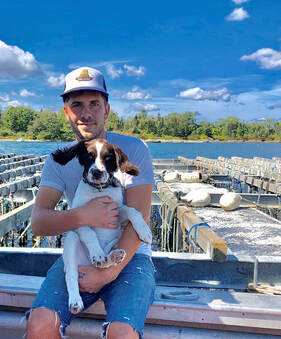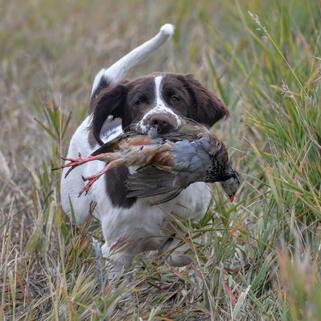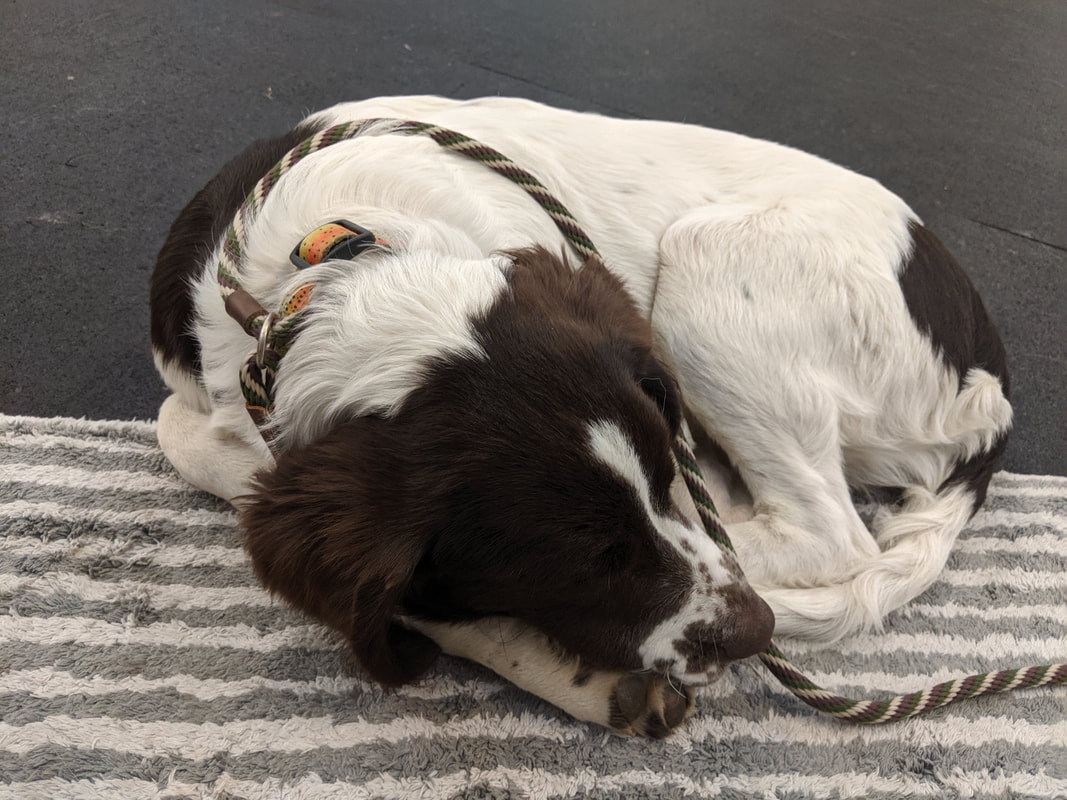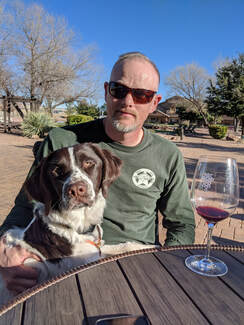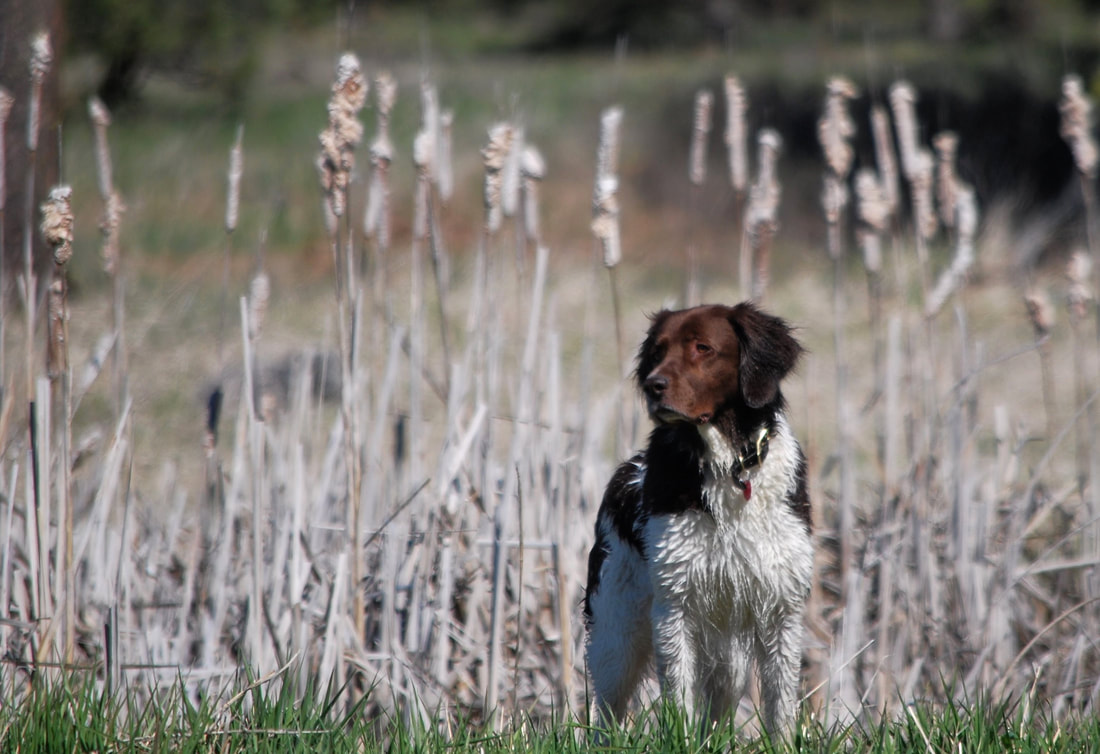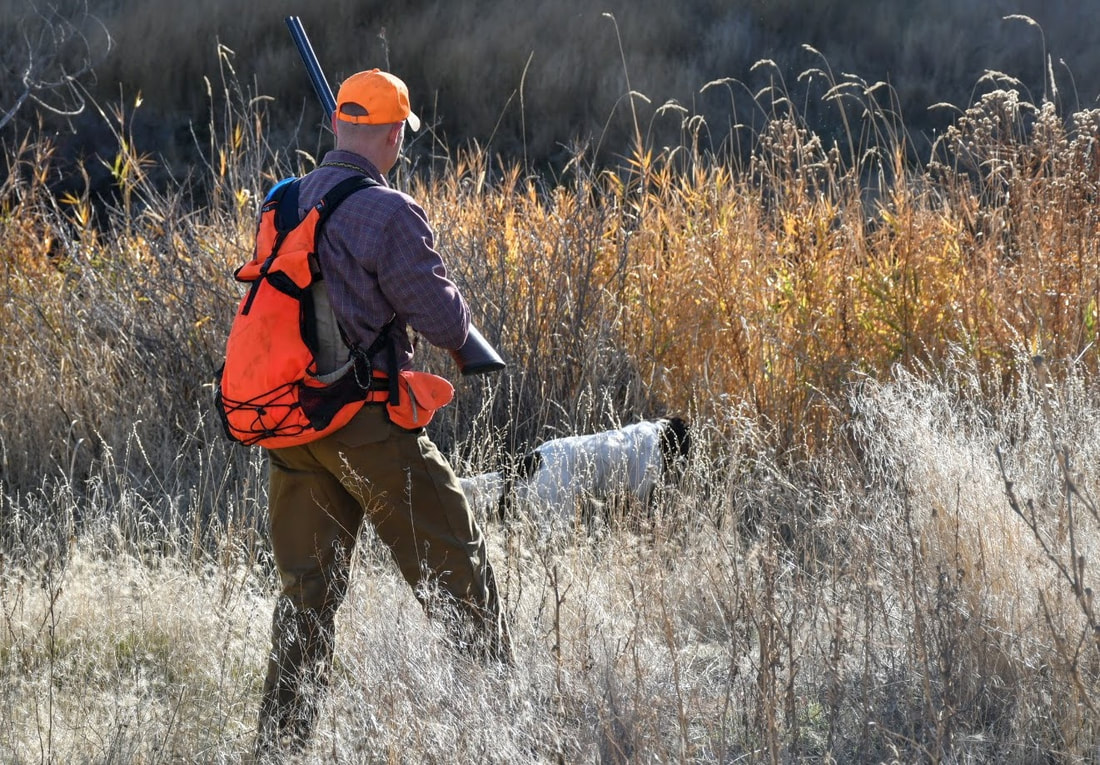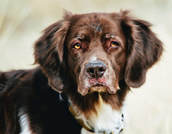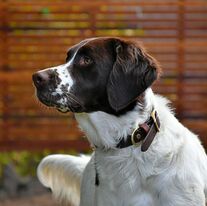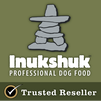With that all being said, what does it mean to you having a puppy or dog with a limited Registration? If you have no intent to show your dog in an AKC show ring or breed him/her, then it means very little as all performance events are open to you and there isn’t a negative impact with non-conformation AKC events, NAVHDA, IABCA or UKC participation.
What if you decide you would like to start participating in Open Shows and your puppy went home on a Limited? A Limited registration can always be changed to full later on if you decided you wanted to try the Open Show thing. You have to initiate the paperwork with us and the AKC will charge you what amounts to a nuance fee to make the change (currently $25). The only difference with limited is that you cannot show in open shows and puppies can't be registered out of the dog, but you still get the pedigree, registration number and all official documentation from the AKC. You can participate in every AKC non-conformation venue. What if you would like show and/or potentially breed and want those options open? Well that is between you and your breeder (us). For those wanting to show, there is a very easy solution -- we enter into a co-own arrangement with you. Co-ownership with us means that one of us goes on the AKC paperwork along with you. As far as the AKC goes, the only venue in which full registration is required is to enter Open Shows and win Certificate of Merit points. As mentioned, you can do AKC hunt tests and all the other titling sports without full registration. So for this, it allows our clients that want to show to have the ability to do so, while allowing us to manage rights regarding reproduction/breeding, to include mentoring when it comes time to find a partner for your dog. If breeding (or providing stud service) becomes something you would like to explore, we want to ensure the dog is what we hoped & expected, that the basic health testing has been accomplished (is passing) as well as hunt testing, and show ring exposure in particular if/when breeding (made available for stud) becomes something you would like to pursue. To help us with evaluation, with co-owns, we have a higher expectation of getting regular photos of the dog as it matures. Ultimately, there is no downside. For us, co-ownership doesn't involve any of your day to day with the dog. It only provides a method of having some say over what gets bred. We hope that all makes sense!
0 Comments
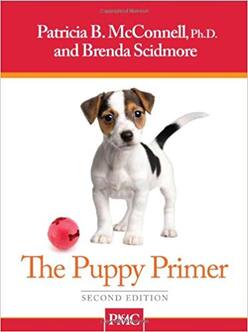 We used to send this by email to our clients many months in advance, now it lives here getting updated from time to time and the link finds its way to your inbox. Yes, we know, it could be a year or more before a new Two Gun pup will cross the threshold into your home. Which means, right now is a wonderful time to start looking into different training options and methods, as there is little pressure. You can read, ask questions, seek out advice, find a local trainer: observe training sessions, etc. and really see what is going to work for you. Making these kinds of decisions once you have the puppy is a whole lot like attempting to fix an airplane while it is in flight...generally not advisable. So here it is, I have dusted off the Recommended Reading list yet once again. What do these books have in common? They are in tune with modern canine behavioral science vs. the old school ways. We believe in working smarter and not harder whenever possible and these resources will certainly help you to do so. Don't Shoot the Dog! The New Art of Teaching and Training, by Karen Pryor The Puppy Primer, by Patricia B. McConnell - for that matter, any Patricia B. McConnell book on training/dog behavior How to raise a puppy you can live with, by Clarice Rutherford When Pigs Fly! Training Success with Impossible Dogs, by Jane Killion, founder/creator of Puppy Culture. This book picks up where we left off with the Puppy Culture protocols, we used with our puppies and isn't just for "impossible" dogs! However, those who are intending to develop your Drent for field work please disregard pages 80-84 her ball & tug games run contrary to your aim. Dog Sense, by John Bradshaw The Genius of Dogs, by Brian Hare Absolutely Positively Gundog Training, by Robert Milner. To learn the mechanics of "Positive/ Force Free Training" and developing a retrieve based on stimulus control. The Drentsche Patrijshond for the North American Fancier, by B. P. O'Connor Since we have you here in the mindset to learn and read. In short, the "early" pediatric spay/neuter is being strongly implicated/tied to joint irregularities, tendon injury, and even increased the risk of many cancers, amongst many other developmental issues, please take some time to review these scientific articles:
There are also some great training resources on the internet:  Leerburg / The Michael Ellis School for Dog trainers: Michael Ellis is considered by many to be one of the World's Greatest dog trainers. He uses LIMA principles to achieve incredible performance from a wide range of dogs for all types of dog sport. Michael's system covers a wide range of topics and is both highly effective, humane, and applicable to all aspects of canine sports. McCann Dog Training: I am a big fan of McCann as they offer a wide range of well put together videos covering all manner of training challenges using Rewards and Markers, and even offer online courses here. Dog Training by Kikopup: Run by Emily Larlham, owner operator of Dogmantics. She shares her impressive skill with easy to learn and follow videos for the regular person. Solving unusual problems suddenly got easier, if not surprisingly fun using her methodology. Higgins GunDogs: Mr. Higgins has used his experience and background in training falcons for the benefit of gun dogs. This method hinges upon a dog's natural cooperation with his boss/co-hunter. The Higgins method isn't exactly 100% fully force and pressure free as its creator pitches. However, the Higgins Method presents stress to the dog in a minimalist and constructive fashion and is without question the best overall and most humane, system for training and managing a high drive gun dog! We use the Higgins Method with all our dogs. Regular visitors to this spot will note I have included Standing Stone Kennels, removed them, reinstated them, and now note they are off again... They have been moving in the right direction. It is important to note that SSK pays their bills by producing content on a rapid production cycle. So, it is important to recognize that the quality of their content varies widely. A knowledgeable trainer can easily sort the wheat from the chaff whereas the novice may not. Therefore, my best advice is to use their content with objective care, or leave it be if you don't know what good training looks like.
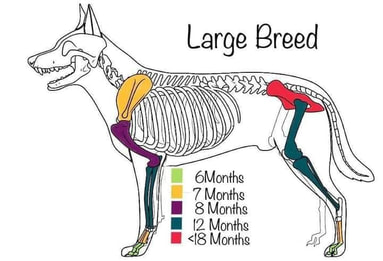 Drents are at the large end of Medium-size, or at the small end of Large-size for dogs. We like the idea of being safe vs. being sorry. So, when you have an intelligent and active breed like the Drent and you have all sorts of ideas for activities and training to do with them, please have a look before you make up your "work schedule" for your precious pup. Today we bring you the explanation why we should not perform intense physical exercise with puppies until 18 months or even 24 months. Puppy growth rates vary by size. It's important to adapt diet and exercise to your puppy s' specific requirements to ensure ideal skeletal development. Endochondral ossification (the process during which cartilage turns into bone) differs according to the adult size of your puppy, with closed growth plates (complete ossification has occurred) between 3 months in toy breeds and 24 months in large breeds (see photo). There are many factors affecting growth rate and maturity age, for example, males mature more slowly than females. There are variations in periods of 'fast growth' ranging from birth to 11 weeks in small dogs and toys. Large breeds range from birth to 20 weeks (Hawthorne et al 2004) excessive exercise and inadequate nutrition during these periods can lead to conformation and malformation of bones, which can lead to the osteoarthritis and degenerative joint disease. The recommended exercise levels for puppies are 1 minute for each week of their life, twice a day. This should be negligible impact at a steady pace. If your goal is to train to compete for flyball or agility (for example), it is recommended to avoid any jump training until full ossification has occurred. This is what we mean to tell you not to rush with your pups, work other things with them. Work their minds, smell, worry about socializing etc. After spending the development months and making the corresponding plates, consult your veterinarian if your dog is 100 % for sport. When you get an 8-week-old puppy, keep in mind these images!
His bones don't even touch yet. They walk great with large, flexible legs and wobbly moves because their joints are composed of muscles, tendons and ligaments covered in skin. Nothing fits right or has a real grip yet. So, it is critical to not allow the puppy to become overworked or over exercised during this time. This relaxed pace allows the puppy the opportunity to grow properly. Every big jump or bounce causes bone impacts...in reasonable amounts, it's not problematic and it is normal. But when you let the puppy jump up and down from the couch in the living room or bed, have free access to run the stairs, you take him for excessively long walks, you can damage that joint during training. A well-formed body is something that comes from excellent parenting and education, BOTH, not just one. Once he grows up, you'll have the rest of his life to play with and perform high-impact exercises with him. So, keep calm while they're still small puppies and give them the gift that can only be given once. 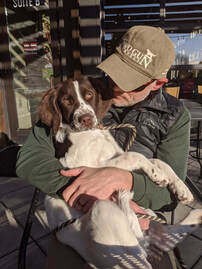
I love fielding questions from our clients! We offer 24/7 tech support, but I'll just go ahead and say it. It's much easier to head problems off before they occur, then to fix them after they have been allowed to manifest.
We used to have a hard time finding clients with enough time to adequately care for their dog, now it seems everyone is working from home and has time, but this creates new challenges. It seems the big one is, how to keep a pup quiet while I'm Zooming. The next one in line is heading off Separation Anxiety, which should be managed before it even has the chance to manifest.
With a Drent, and most active sporting breeds, a balanced approach is really the way to go: Body & Mind. 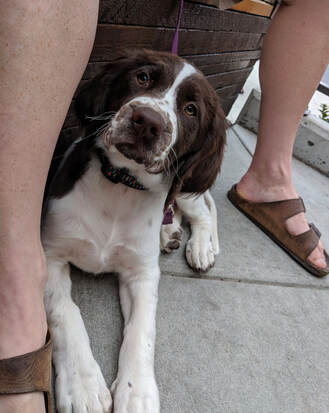
Body:
Many folks assume taking the pup for a lot of exercise will help them sleep the day away. To a degree it works like that, however, it will also create a dog that requires exercise... How much running makes a marathon runner tired? Trust me, for the first couple of weeks after hunting season is over, the natives are restless. During the time a pup is young you really can't take them for rigorous or forced exercise. Fortunately for a young dog it doesn't take much to wear one out... it's when you get to the teenage-time that they can go for quite a bit of exercise 'at their own pace' and they will also begin to develop stamina. This is a one dimensional solution that becomes both self-limiting and its own problem. As a side note: a Drent really needs to be at least a year old to start becoming a running partner, even then, shorter runs with varying pace as you work pup up to it. 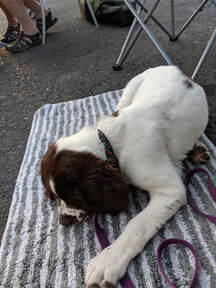
Mind:
There is a time where using distractors: toys, chews, brain games, etc. is great. Just as important to getting pup out to stretch his legs, but on its own this too becomes self-limiting. As it puts the burden on you to find ever new and more enticing ways to focus your dog's attention. In fact, by spending too much time in the 'mind zone' you can actually defeat your Drent's natural 'off switch' because your dog will always need to be entertained with something! Ever meet a kid who needs to be entertained constantly to stay quiet and out of the way? I'm pretty sure you have... it was fun wasn't it? 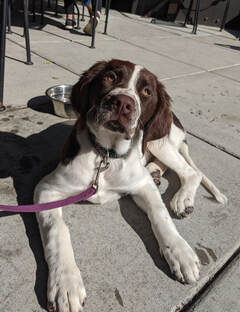
So I just took your whole plan away you say? Well, if that was your plan, then I suppose so and I wasn't even trying - ouch!
So let's do this instead, because I see them as as related. You need balance, Body & Mind, but let us also take advantage of one of the things that makes living with a Drent pretty awesome - let's do some deliberate work on their natural 'off switch' and we do this by teaching the dog to settle! Teaching 'settle' also helps with crate training - which you will need to do as part of your regimen. Also now with so many people being 'home based' these days, taking a proactive approach to avoid separation anxiety has a level of importance many have yet to realize! Yep, that's right your increased availability has a Darkside... So let us head all of this possible drama off at the pass, this is the way. Please take a few minutes to watch these videos:
You can see they are very similar, basically a subtle variation on the same theme - you can find dozens of similar videos on YouTube, and all the better ones will more or less resemble what I have posted above for you. We did this with Ila, and by 5 months she was an Old Hat at being a pro-pub dog! 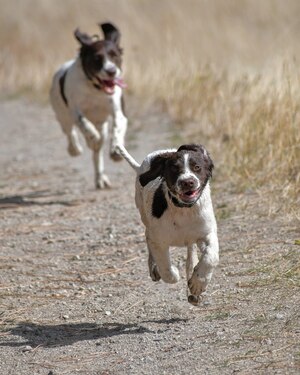 Some of the inquiries we get might surprise you. As you might guess in this day and age, many lack basic common courtesy – the worse of which we simply don’t even acknowledge. The better of which will we provide at least a reasonable, if not short, but professional response. However, recently we fielded an inquiry about how to bring a new puppy home. The answer for this question is best provided by the breeder you have acquired your pup from, or even Google vs some random breeder or person. After all it's not a short answer. A rather odd request from someone who you have not had nor plan to have any future interaction with. I provided some basic info, then reviewed our own puppy related materials and realized it wouldn’t hurt to add to what we have started. So, for that, thank you random person for your questions. This also this helped to make good on a client’s request on putting all this stuff in one place – I didn’t really know how to do it, but this is what I came up with. Part 1: What is the best way to acclimate a new puppy into the home?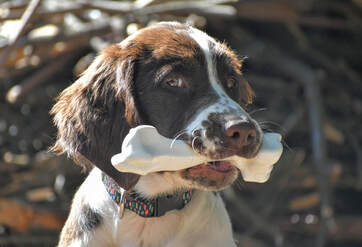 A great place to get setup for success is to review each of the articles highlighted by the hyperlinks throughout this article to include reviewing our Recommended Reading for new puppy owners. Getting Set up for Success is where we talk about all sorts of things ranging from general physical concerns and needs for a rapidly growing puppy's joints & bones, as well as puppy proofing your home & yard. Here is a list of puppy essentials for what your puppy will need. Oh and not to forget, how do you plan to manage the messes that will happen, during your potty training adventures? Additionally, have you nailed down a teething management strategy,? Some pups will chew like a beaver, and others hardly any, but knowing what to do in advance can help shape all of their desires. Have you considered coat care, and the tools and time required? For Drents it’s pretty easy, but still it’s something you should have thought about. Extending this thought process, you will want to be sure you have a veterinarian selected, if you don’t have one already, well in advance to bringing pup home. Also, what do you plan to feed pup? You don’t need to feed the ultra-expensive stuff to have a happy, healthy dog, but if you are considering to feed Old Roy, you should consider putting yourself on a diet of corn and rice hulls seasoned with charcoal, and for a big night out you guessed it – Top Ramen. 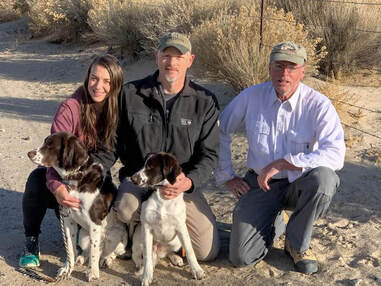 Next, you will also want to have a socialization and training plan thought through in advance. The more comprehensive, the better. At the minimum we strongly encourage everyone to update what they know, or think they know about dog training. A lot has changed with the advent of the scientific study of Canine Behavior: Example 1, Example 2, Example 3. The old concept of Alpha/Dominant v. Submissive is quaint. The old techniques of traditional obedience training are at best boring and repetitive. These methods tend to be unkind, bordering on inhumane. Not even thinking about the old ways of bird dog training which if we are to be frank can be quite barbaric. We can and should do better, by looking towards trainers like Brad Higgins, McCann Dog Training, and Stonnie Dennis, for example. You should seriously consider enrolling pup in a certified AKC S.T.A.R. puppy course and shooting for achieving an AKC Canine Good Citizen certification. Part 2: How do you Introduce pup to your other dogs?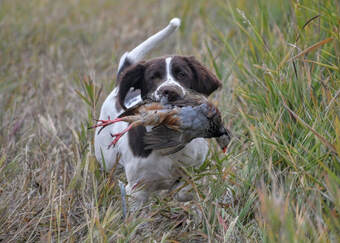 Alright, so The Pup is en route - what to do? Each dog should ideally have its’ own handler – this really can make it or break it if things were to slide sideways. Both dogs should be restrained by a leash initially. Allow them to sniff one another. Expect pup to maybe be a little bit timid or restrained. If so, it may be appropriate to allow the pup off leash to make its own introductions on its’ own terms. In this case restraining the adult dog can be important as they can get over excited and without meaning cause harm to the pup, in particular if much larger and stronger. With a little care, some calmness and patience, introducing pup should be fairly quick and painless. However, pup and Fido-1’s interactions will need to be supervised for the next few days. Play sessions will likely need to be supervised for the next several months, remember avoiding serious injury to pup is paramount – when in doubt call a timeout. With that in mind, here are a few other tips for success: Be aware and don’t leave yours dogs alone and unsupervised. Avoid free feeding and encourage waiting when it is feeding time. When you offer special treats e.g. chews and/or raw hides, ensure there is enough for all, supervise, and pick them up long before they are fully consumed. Please be sure to have an ample supply of toys and beds. If one toy becomes a point of contention, retire it. Monitor play time be aware of body language and if/when needed redirect and give timeouts as appropriate. To the greatest extent possible give each dog a little bit of its own time. We believe through daily, structured walks; your dogs will respect you as the boss and look towards you for guidance and direction. Daily, structured walking is a great way to establish your benevolent leadership. After a month of careful supervision, correcting misbehavior, structured walking, and supervised feedings, your dogs will know you are the boss and the new/old dog is not a threat. Once your dogs begin to feel safe with one another, their true personalities will come out and you will have two wonderful pack members to entertain you and love you for the rest of their lives. 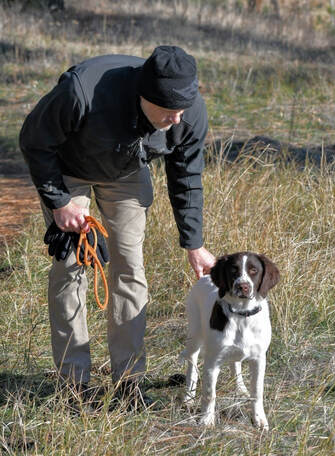 So, if have been caught be the Drent virus, you are likely adding to your clan. Or if you are recently afflicted, you may still have another dog as part of your clan. Either way, you need to integrate. If you don’t already have a dog, my initial reaction is to pass this up…but my better sensibility says take a moment to read, and let it marinate for a later time – after all, you have the Drent virus, and there is no known cure. Alright, okay, enough shenanigans – I’ll get to it…well, not to be special, but you are here on my blog so endure. You need to introduce pupski to an established adult dog. So, let us consider the established dog for a moment. Is he a model canine citizen? Let’s be honest, you know him far better than anyone so there is no need to tell any stories or make excuses. Does Fido-1 have separation anxiety, excessive barking, destructiveness, house training issues, aggressiveness/shyness towards other animals/people? If so, you should really work on getting those issues remedied – puppy will not help any at all. What you can expect pupper to do is to pick up some, if not all, of these less than desirable traits unless YOU have a clear and decisive plan, which is likely to involve external onsite assistance. Because the only thing worse that one canine terrorist, is two (or more, God forbid). Okay, so your current dog is more or less well-adjusted and well behaved. Finding balance is likely the path to success. This doesn’t mean if your dog is a total couch potato you should add Hellfire the Tasmanian Spaziod to the equation - what is or will be complimentary? What temperament and personality will compliment, coexist, or coincide with what you currently have? With some deliberate thought you can create some amazing canine partnerships. Part 3: Crate training - what is that all about?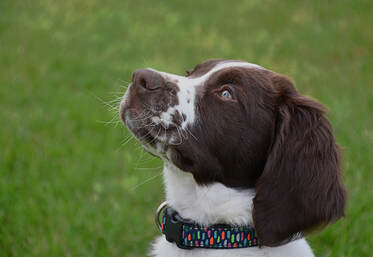 Some people want to think a dog crate is a punishment tool, when in reality a properly sized crate is your dog’s home inside of your home. This, as you might imagine, has a few benefits like helping to potty train pup, keep pup safe when you can’t supervise him adequately, to name just a few. It is important to have the crate properly sized and built to be safe and secure. A dog’s crate should be a happy place. The training process can go quite rapidly, or it may take a couple of weeks. Always have in mind, the crate is the dog’s house, and it should be a pleasant place for him. Generally, this can be accomplished without too much ado by breaking the process down into a few steps, just be mindful not to rush. A handy, mobile, oft overlooked and undervalued tool is teaching your dog to settle. Drents have a natural 'off switch' so why not cultivate it and use it to your advantage? In doing so, it will help with crate training and in turn separation anxiety if you happen to be home based as many are these days. Who knows, you might even end up with a super cool 'pub dog' that everyone is jealous of... Now back to crate training. Introduce pup to the crate. Do so calmly and be sure the door can’t slam around or close. Put some of pup’s favorite things into the kennel along with a few treats. Drop a few treats near the kennel, then just inside the door, then toss a few treats in. Let pup take his time to go in. We familiarize our pups with kennels in the whelping box – so this should be super easy. However, at first, this will be new in his new home, so a little bit of patience will serve you well. Once pup is going in the crate well on his own, be sure to feed him at least once a day, or possibly all his meals for a little while in the crate. At first with the door open, then gradually work towards shutting then even latching the door for short periods. Work up to 10 minutes or so after eating. Here is where things can get tricky, and you will need some will power to get through this. If pup whines in the crate, you did too much too fast and here is the catch, you can’t let pup out while he is whining or crying. You can sit by the door, even place a finger in for pup to smell and help calm him. Once the whining has stopped, and this could be a while in some cases, you may then open the door. If you open the door while the pup is crying it very well may make the association and begin doing much more crying and whining – just what we want to avoid. You may need to have pup close by in his crate at first, and just like ‘playing with the door’ you can adjust proximity. Evening TV time, or some other calm time is perfect for working on building familiarity and comfort. Also McCann has an entire crate training series which you may find helpful.Some people want to think a dog crate is a punishment tool, when in reality a properly sized crate is your dog’s home inside of your home. This, as you might imagine, has a few benefits like helping to potty train pup, keep pup safe when you can’t supervise him adequately, to name just a few. It is important to have the crate properly sized and built to be safe and secure. A dog’s crate should be a happy place. The training process can go quite rapidly, or it may take a couple of weeks. Always have in mind, the crate is the dog’s house, and it should be a pleasant place for him. Generally, this can be accomplished without too much ado by breaking the process down into a few steps, just be mindful not to rush. A handy, mobile, oft overlooked and undervalued tool is teaching your dog to settle. Drents have a natural 'off switch' so why not cultivate it and use it to your advantage? In doing so, it will help with crate training and in turn separation anxiety if you happen to be home based as many are these days. Who knows, you might even end up with a super cool 'pub dog' that everyone is jealous of... Now back to crate training. Introduce pup to the crate. Do so calmly and be sure the door can’t slam around or close. Put some of pup’s favorite things into the kennel along with a few treats. Drop a few treats near the kennel, then just inside the door, then toss a few treats in. Let pup take his time to go in. We familiarize our pups with kennels in the whelping box – so this should be super easy. However, at first, this will be new in his new home, so a little bit of patience will serve you well. Once pup is going in the crate well on his own, be sure to feed him at least once a day, or possibly all his meals for a little while in the crate. At first with the door open, then gradually work towards shutting then even latching the door for short periods. Work up to 10 minutes or so after eating. Here is where things can get tricky, and you will need some will power to get through this. If pup whines in the crate, you did too much too fast and here is the catch, you can’t let pup out while he is whining or crying. You can sit by the door, even place a finger in for pup to smell and help calm him. Once the whining has stopped, and this could be a while in some cases, you may then open the door. If you open the door while the pup is crying it very well may make the association and begin doing much more crying and whining – just what we want to avoid. You may need to have pup close by in his crate at first, and just like ‘playing with the door’ you can adjust proximity. Evening TV time, or some other calm time is perfect for working on building familiarity and comfort. Also McCann has an entire crate training series which you may find helpful. 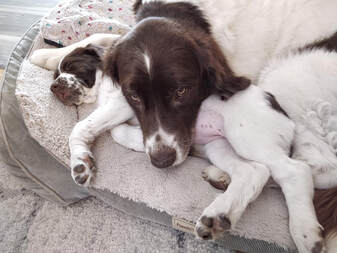 Crating pup overnight: Alrighty, now it is really time to start to work with longer crating periods. We have found doing this while you are at home really is best as you as easily start adding some structure to an already familiar event. Here are your marks:
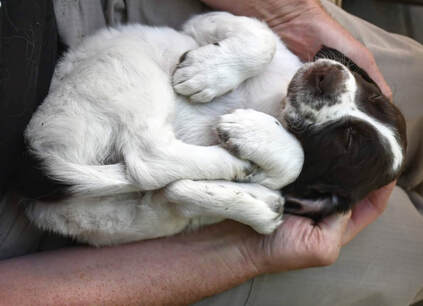 Yes, this can appear to run a bit contrary to to the whole training process, and frankly can be the most difficult part of crate and potty training – the night shift. Leaving pup out all night is surely going to result in a mess, damage to something, pup getting into things which might harm him, or for a real banner night all or a combo. Crating at night is a must until pup has proven himself reliable in all ways. Generally, it’s a good idea to put the crate in your bedroom if space permits or nearby in a hallway. Young puppies will need to go potty during the night, and you'll want to be able to hear your puppy BEFORE they whine to be let outside. Put pup in the crate using your regular command and a treat, know what pup’s potty schedule is (going potty just before bedtime is an absolute must), so that you can set a gentle alarm to take him out just before his normally scheduled time. Expect to get up at least 2 times each night for the first few nights. As his day schedule lengthens his night schedule should as well. One bit of advice here is to pick up the water bowl about 2-2.5 hours before bedtime. Soon your dog will be sleeping comfortably through the night with the crate near you, you can begin to gradually move it to the location you prefer, although time spent with your dog—even sleep time—is a chance to strengthen the bond between you and your pet. 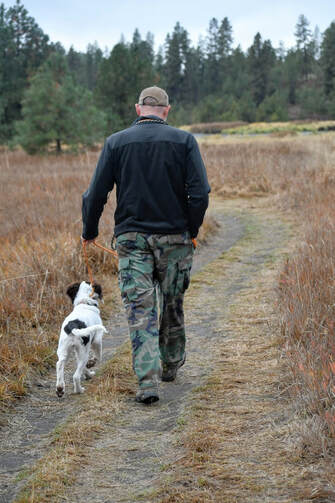 Potential problems: Whining - If your dog whines or cries while in the crate at night, it may be difficult to decide whether they’re whining to be let out of the crate, or whether they actually need to be let outside to eliminate. If you've followed the training procedures outlined above, then your dog hasn't been rewarded for whining in the past by being released from their crate. If that is the case, try to ignore the whining. If your dog is just testing you, they'll probably stop whining soon. Yelling at them or pounding on the crate will only make things worse. If the whining continues after you've ignored them for several minutes, calmly take the pup out of the crate and carry outside. This should be a trip with a purpose, not play time. Give your “go potty” command and give pup a few minutes to get the job done. If he goes potty, give a calm “good boy” and carry back to the crate without a fuss. If he does not potty, then without drama take pup back to his crate. Potty or no potty ends with the same outcome - trips in the middle of the night are for necessity only, and the crate is a requirement until it’s time to start the day. If you're convinced that your dog doesn't need to eliminate, the best response is to ignore them until they stop whining. Don't give in; if you do, you'll teach your dog to whine loud and long to get what they want. If you've progressed gradually through the training steps and haven't done too much too fast, you'll be less likely to encounter this problem. If the problem becomes unmanageable, you may need to start the crate training process over again. Separation anxiety - Attempting to use the crate as a remedy for separation anxiety won't solve the problem. A crate may prevent your dog from being destructive, but they may get injured in an attempt to escape. Separation anxiety problems can only be resolved with counterconditioning and desensitization procedures. You may want to consult a professional animal-behavior specialist for help. 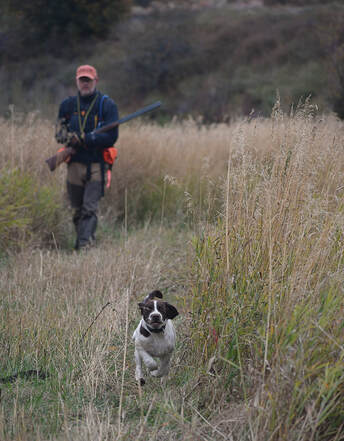 You can make owning a dog as expensive as you want. Truth be told, to keep a dog, you really don’t need a lot of fancy things and expensive equipment.
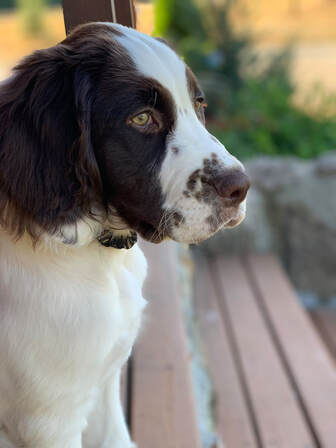
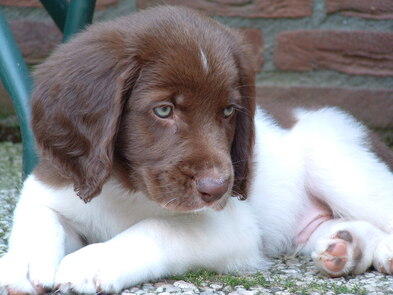
What is Puppy Culture?
Puppy Culture is a program developed by Jane Killion, professional dog trainer and breeder. It is a comprehensive, organized program for breeders to follow during the first weeks of a puppy’s life. The first 12 weeks of a puppy’s life are incredibly important. This is an almost magical time when a breeder has the power to change the outcome of a puppy’s life by what we choose to teach him. By doing just the right things at just the right time, we can give your puppy the best start possible. Prenatal Period Making sure that your puppy’s genetic material is excellent is only the beginning. The physical and emotional health of the mother will affect the health of her puppies. Since research has shown that puppies born to mothers that receive prenatal massage are more docile and enjoy being touched, we spoil our mothers with lots of affection and belly massages. A puppy’s predisposition to form deep and meaningful relationships begins even before they are born. Neonatal Period: 0-14 days Early Neurological Stimulation (ENS) begins on day 3 and continues through day 16. Research shows that tiny struggles and stresses in appropriate small doses are actually good for puppies and will help them grow into strong, healthy well-adjusted adults. Benefits include greater tolerance to stress, greater resistance to disease, faster adrenal system, stronger heart rate and stronger heartbeat. This is a gift that a breeder can only give their puppies once during the window of 3-16 days. Transitional Period: 14-21 days Behavioral markers are used to identify the beginning and end of each developmental period because every puppy is different and these timelines are simply guidelines. The transitional period begins when the puppy’s eyes open and ends when they first startle upon hearing sounds. Critical Socialization Period: 3-12 weeks Most people think of socialization as exposing their puppies to as many new experiences as possible while the puppy is young. While this is part of the process, it’s not enough. Our goal is to raise dogs that have the emotional intelligence to connect with you. Emotional intelligence can be taught to young puppies and one of the goals of the Puppy Culture Program is to teach breeders how to do this. There are 7 key things that will nurture the emotional intelligence of a puppy. 1: Communication – giving a puppy his own voice: Communication Trinity – power up clicker, box game, manding, attention/distraction protocols 2: Emotional stability – the ability to recover easily from fear as well as stress (startle recovery, barrier challenges, Volhard Puppy Aptitude Test at day 49 3: Habituation – familiarity with the maximum number of things: Puppy Parties, sound protocols, habituation soundtracks and noises, meeting different people, dogs, other animals 4: Enrichment – the view that novelty and challenges are opportunities for enrichment rather than things to be feared or avoided: novelty items, Adventure Box, off premises socialization 5: Health – physical wellness and motor skills that will allow the puppy to develop in a neurologically and physically sound way: daily weight checks, grooming, vaccinations, deworming, proper nutrition, vet health checks 6: Skills – learned behaviors which allow him to function in human society: recall, manding, simple commands, litterbox training, crate training, leash walking, resource guarding, bite inhibition 7: Love – the desire to seek out the company of both dogs and humans as emotionally positive experiences: shaping emotional responses, Happy and Calm CER (Conditioned Emotional Responses), daily cuddles with humans and mom This is definitely an incredible amount of work, but it is 100% ABSOLUTELY WORTH IT!!!!!! When you adopt your puppy, you will be just as thankful as we are for this program! The "Why" of Puppy Culture from Jane Killion on Vimeo. 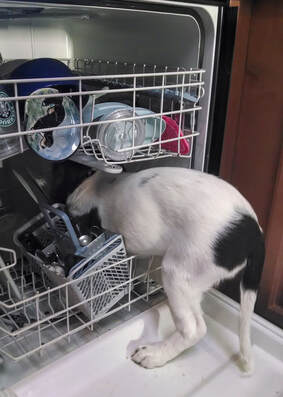 Impulse Control, is pretty much as it sounds - puppies and some (too many, perhaps?) adult dogs lack an appropriate amount of impulse control a.k.a good manners. Once a dog has learned impulse control, quite literally everything which follows is much easier and tends to come along at a much quicker rate. We humans tend to make raising a puppy much more complicated than it needs to be. Impulse control could even be called distraction management, but that is even more to say and type, either way it is a skill which will help a dog to concentrate and remain focused to a task, be it running an agility course, going your local pub to chill, running some field work, and all points in between. Teaching dogs this skill isn’t harsh, but it does require consistency. I’m guessing you have taken a moment to see how long this article is and might be thinking about jumping ship because you think you might not need to read all of this. I’ll make you a deal. You are free and clear unless you answer yes to one or more of the following questions. If you do, you need to make some time and read the whole thing. Here we go: Do you find yourself competing for your dog’s attention? Is your dog easily distracted by other dogs or people? Is he more likely to follow his nose than you? Does noise or movement get him excited? I’m not a gambling man, but I’m guessing you are with me for the long haul, so I’ll try to make this easy. 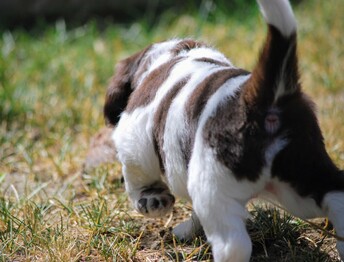 You answered yes, so let’s get started. Like most undertakings, start with realistic goals. You’ll need to break the process down into bite-sized pieces to keep from becoming discouraged or putting undue pressure on your pup. Secondly, you don’t need any special tools or skills. If you can say ‘yes’ with a smile on your face and can stock some ‘high value’ treats you are all set. Since I mentioned ‘high value’ treats let’s take a quick sidebar to be sure we are on the same sheet of music. You can’t be offering your dog kibble or frankly most of the over-priced stuff offered at the pet store as it just isn’t good enough (unless of course you need a low value treat…). I prefer to use hot dogs; you could use string cheese. I split them lengthwise with two cuts (making three pieces), then rotating 90 degrees and making two more cuts (making nine pieces). From there these hot dog strips get cut perpendicular to make as many little squarish pieces as I can get. Basically, anything approaching the size of a pencil eraser is too big. Training treats do not need to be big to be useful, they need to be small, tasty, something the dog can just ‘inhale’, and be very compelling for the dog! 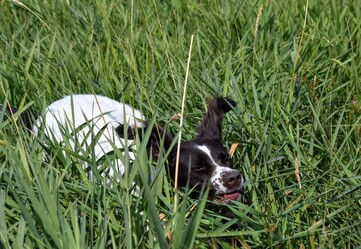 First Step, The Name Game: Alrighty, let’s start small by having your pup nearby and your high value treats in a small pouch by your side. You will begin the Name Game. Take your puppy and go to a quiet place devoid of distraction, say pups name. When he looks at you, say ‘yes’ immediately and treat him – that’s it. It’s just that easy. If pup looks around a bit before he looks at you, that is okay. Just be sure to expect this, and only say ‘yes’ and treat once he does. If you need to repeat his name, you can, but be calm and wait a few seconds before repeating. You must refrain from using a machine gun burst of his name. Once he understands looking to you gets him a reward, do the exercise with him a few more times. As he improves, you can gradually add some distraction in the distance, use things that aren’t too enticing for him and as he progresses with the Name Game, you can ‘up’ the distraction. This is applied in the same way with all the exercises I am going to talk about here. In the early weeks of training don’t be shy with “loading the name” as many trainers call it, which means once he really gets it, and holding your eye, you can pump him up with a few extra treats and even add some verbal praise. Once he becomes bulletproof consistent with the Name Game, start to break up treating him by make treating him inconsistent and then less and less frequent. Be sure to always reward him with a ‘yes’, in the early stages and as you taper the food reward. You can always affirm his correct/appropriate response with a happy ‘yes’ as you see fit. The key to how this method of training works is giving pup a chance to decide on their own and making it easy for the pup to decide that following your lead is the way to go. The ‘Name Game’ has has a few layers, besides teaching pup to look to you when his name is said. Eventually his name can act as a preparatory ‘command’ of sorts by letting him know something else is likely to follow. But for now, we just need to see how this progresses. Ultimately, pup might figure the game out quickly and decide to become pushy about his treat, this too is a great situation and learning opportunity for pup. Always say ‘yes’ when he looks at you, but only treat pup when he is calm and looking at you (standing or sitting, whichever is what you want to reinforce). If he is being pushy just be calm, say and do nothing, simply wait him out. Give him a ‘yes’ once he calms and treat. Eventually you will want to extend the amount of time pup needs to look at you before being treated. There is no real need to set aside special training time to do this, just a moment of deliberate thought and preparation is all that is needed. As pup progresses with this exercise, try new locations, and gradually introduce a few distractions. We want to strengthen and generalize this association. 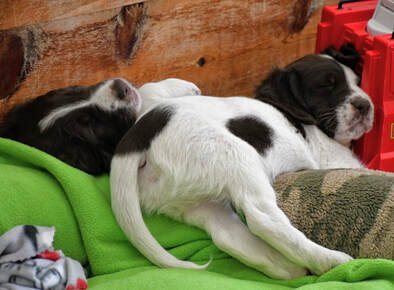 Getting more from the Name Game… Bonus round one! While playing the Name Game, you may find that your pup chooses to move closer to you and offer to sit for you. Bookmark this, for after he has gotten a solid grip on the Name Game. Then one day, just as pup offers his ‘sit’, give him the verbal cue (aka for you Old Schoolers out there, the command, sit), once he has sat, say ‘yes’ and treat. You are now beginning to build a new association. If you happen to not have treats with you, you will always have your ‘yes’ handy. Remember, with Name Game play, you have built an association with ‘yes’ and he knows and associates ‘yes’ with praise and reward. This is what I like to call ‘knocking ‘em down’. All these skills are all dovetailed together and building on one another making each skill easier to teach the next. Please resist your temptation to tussle pups ears and rub him up excitedly. This only adds energy to the situation, and most likely to get pup bouncing around, or even more depending on how reactive your dog is. Remember we are teaching him how to be good citizen here – to be calm, assured, and pleasant. Your dog will tend to mirror the energy you are putting out. 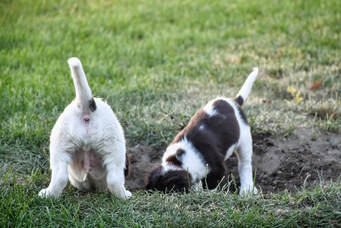 Getting pup out the front door Like having a toddler, with a pup, you need to plan to get ready before you intend to be ready…this gives you the upper hand. It gives you the time to do what is necessary; to be consistent, set the pup up to win and you to be the victor. All without needing to flex a single muscle! So, you want to take pup for a ‘Leader Walk’, or load him into the car… Go to the door and grab your leash. Odds are pup will begin to bounce around like a fool. If you were in a rush, you’d be grabbing at him, telling him to sit fifteen or twenty times, and maybe even get a little bit frustrated. If so, all you have taught your dog in that moment is to act like a fool and that preparing to go is a game where not listening is okay. The Leader Way would be to approach the door and grab the leash. Turn to the pup and wait. Don’t say a word, do not encourage anything. You could say calmly, ‘when you’re ready’ or my favorite, ‘what do good dogs do?’ – honestly it doesn’t matter what you say, what’s more important is your tone of voice. Odds are he will react by calming down and possibly sitting. Be prepared. If he hasn’t built an association with going out the door, you could just say his name and see what happens, if you are well into the Name Game and starting his sit work. Either way, once pup is nearby and offering a sit, say ‘sit’. Follow-up with ‘yes’ and then gently attach his leash. If your movement is too much for the situation, just start from the top and take your time. It will not be long; he will sit calmly and allow you to leash him and without fanfare head out. Now he has learned how to go through the door and that you are in charge. 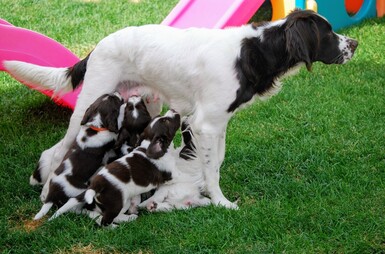 Thoughts on Shaping & Luring. One hand washes the other and back. He will also begin to associate his actions with rewards and verbal cues and later on verbal cues with actions. Yup, the dog is training himself, and you are only facilitating the experience. A big part of your job as handler is to simplify situations by removing distractions and thereby improving the likelihood of pup making the correct association you are intending to make. Offering toys while pup is excited, talking excitedly or yelling, and moving your arms to push pup away when pup is jumping up, only serve to muddle your message and add energy to the situation – making it more difficult to get the desired outcome. Additionally, blurting out random or rapidly fired repeated ‘commands’ (E.g. sit, sit, sit, sit, sit - you’ve seen it, and likely been guilty of doing so) and telling pup ‘no’ to just about any and everything is as equally as futile (and useless). ‘No’ isn’t a command: sit, here, down, stand, leave it, place, kennel all are commands, but only after the association has been made. Remember, the key here is to catch pup doing what you want and offering an affirmation to build the association you desire. 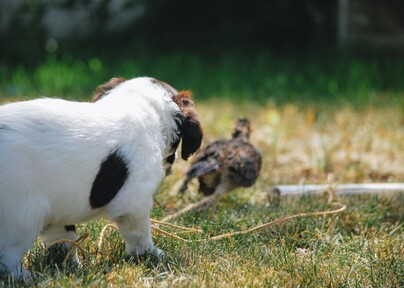 Claiming Space, not as advanced of a move as you might think: If you have been following the Dutch Dog Blog, you know we are big fans of the Higgins Method. Part of the Higgins method of associative dog learning is Claiming Space, and this can have a rather surprising and profound impact of how a dog chooses to manage its energy. Claiming Space ties into teaching your dog impulse control. You will do this during a Leader Walk (detailed below) with pup, but you can also Claim Space in your home, and doing so can really simplify a few things. At mealtime how does pup behave? Is he like a rubber ball that has been launched into an empty swimming pool, bouncing, spinning and acting a fool? Even if you have been blessed in this area, Claiming Space is another exercise to help pup build control and focus. For pups that are pure crazy sauce, you will want not do this at mealtime starting out. You need to build success, not failure. Place pup’s kennel in a place where you can put a chair about an arm’s reach and squarely in front of. Put pup in his kennel and close the door. Remain sitting in front of the kennel, with the door latched, and wait for pup to become calm. This can look many different ways, but ideally, he will lay down and maybe even go to sleep. After calm has been achieved, open the door, but don’t allow pup to bolt out. Be sure to square your shoulders with the opening of the kennel, keep your head in a neutral position (at first) and use your hand to, as gently as possible, give pup a push to keep him in the kennel if required. No word needs to be said. He may be persistent, and you may need to be firm. You will need to be resolute, and you may need to lower your chin, giving yourself a little more of a serious posture. In most cases after a few attempts, pup will simply lay down and accept being in the kennel with the door standing wide open. This is when you can start a conversation with your friend of family member if you have someone nearby – always being attentive of pup. He may try to sneak out on you, and you will need to arrest this, but more than likely you will find he will simply remain in place. If so, perfect! Let him rest a while, then you can let pup know he may leave his kennel. From now on, when you open the door, the door opening is no longer the cue to bolt out. His cue is your release word. Consider using ‘okay’ or ‘let’s go’, some like ‘free dog’. In the beginning you will need to vary the amount of time the door is opened before offering the cue. The association we broke is door opening = bolt. The association we built and want to maintain is your cue = you may politely exit your house. 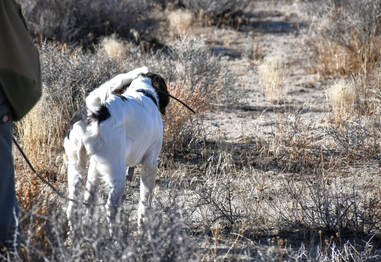 Applying all of this to mealtime to create more Impulse Control. You have now Claimed Space in your home. Pup knows that when you are in front of him, that space is yours. Let’s help him understand this further. I’m guessing you have a carpet in the area where you feed your dog, if not you will want one as it will make this easier for pup to understand. Using all of the things we have talked about so far: the Name Game, the polite offer to sit or stand, and space claiming, pup knows to be on that carpet and knows that he must be there once his food bowl is in play. This will need to be done in small steps, but can be accomplished rather quickly if you have worked up to it… At first the bowl is placed near to the pup once he is calm and ready. Plan on using a similar stance you used with the crate and need to gently claim the space in front of pup where you intend to place his food bowl. Initially the waiting period should only be a second or two, give him a release pat on the flank (later you may build in a verbal cue) and let him enjoy his meal. As this exercise progresses, you may add time and or distance to help build the pup’s focus and association of waiting for your release. 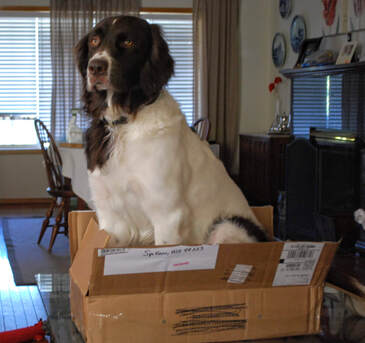 The effectiveness of teaching ‘leave it’ We mentioned teaching ‘Leave It’ near to the beginning of this article. So now let’s spend a little bit of time on the concept. ‘Leave It’ can be taught passively and is a simple variation of what we have been doing so far. Start by putting a lower value treat in your hand e.g. some kibble, then as success builds work towards using your ‘high value’ treats! Begin by having your pup sit or lay down. Whichever you choose, the dog should remain in posture for the duration of the exercise. Have a modest handful of treats in your off hand. Start by holding your baited hand open and above the dog’s line of sight as well as being a few feet away. You sit calmly and if pup stretches towards the treats, simply close your hand. Once pup has relaxed, re-open your hand to start the exercise over. If instead of investigating your baited hand and he looks at you, say ‘yes’ then take a treat from the baited hand and reward him. As the game progresses, the baited hand gradually moves closer and lower to pup. Please note, once the treats get at or below line of sight this game will get much more difficult for pup to maintain posture, so be mindful to not progress too rapidly. You do not want pup to be able to raid your baited hand and self-reward. You should always quickly and quietly close your hand anytime pup shows interest in the baited hand. Some dogs will learn this quickly, others may need several sessions. Once pup has this pretty good you can up the value of the reward and then when pup goes for the baited hand simply add the cue ‘leave it’ when you need to close your hand. Reward once pup looks to you for guidance and/or praise. If your dog really struggles to stay in place to make this exercise possible you may need to recruit a helper to hold his leash. Again, the intent is to set pup up for a win. 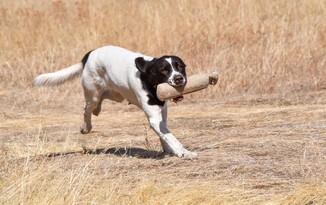 Teaching pup to Settle: Some dogs are naturally pretty chill, but most need a bit of assistance with learning how, and more importantly when to hit the ‘off switch’. Being reactive or overly excitable isn’t much fun for anyone, to include pup. This really comes down to teaching pup a ‘place command’. This can be his kennel, a bed (in one or more locations), or your sofa – it only matters to you. Pup will chill out pretty much any ol’ place. Figure out where you want pup to go. Generally speaking, you will lure pup to his spot using your ‘high value’ treat and once he offers the behavior you desire (lay down), calmly reward and give the ‘command’ you have decided on what that is to be i.e. ‘bed’ or ‘place’ once pup has made it to the targeted place, reinforce with ‘yes’ immediately and treat as soon as you can. Like most things this can progress quickly. To increase the challenge, slowly wean him from being lured into place and then create more and more distance from his ‘place’ when you give the command. Congratulations!
It is never too late to start teaching this stuff, but the sooner the better (and easier) as you might expect. Here are some additional resources on teaching impulse control to the distracted dog. I hope you find them helpful. A dog with a greater ability to concentrate, and stay on task will make everything you currently do easier and make all those plans you have for the future not just possible but easier as well. https://www.youtube.com/watch?v=ZkZuopl-t9k https://www.youtube.com/watch?v=Pg7CX0e4l-I http://www.twogunkennels.com/dutch-dog-blog/help-your-dog-teach-itself The Brad Higgins Leader Walk method: http://www.twogunkennels.com/dutch-dog-blog/teach-your-dog-to-walk-nicely |
Categories
All
Our YouTube Content
Two GunI'm just a guy suffering with an infatuation with gundogs since childhood. Forty some years later this is what you get. Archives
July 2024
|
|
|
